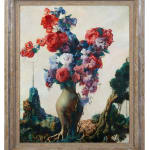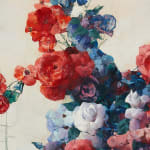Marcel Delmotte
Signature, date and location on the reverse 1961 Marcel Delmotte, Charleroi
The self-taught Belgian painter, Marcel Delmotte (Charleroi 1901 - Mont-sur-Marchienne 1984), was an watercolourist of portraits, figures, nudes and landscapes and was also active a sculptor. In particular, he concentrated on visionary landscapes and large symbolic frescoes.
Marcel Delmotte began as a painter of buildings, becoming a true master of painting the texture of materials, particularly 'faux marble'. At the beginning of his career, he painted realistically, but was later influenced by expressionism. He evolved towards symbolism in the classical spirit and became a precursor to surrealism. His ideology was inspired by Florentine Renaissance masters such as Paolo Uccello (1397-1475) and French classics such as Nicolas Poussin (1594-1665), mythology, the Bible and the Divina Commedia. Large-scale compositions, lunar, mining and industrial landscapes, futuristic architecture and checkerboard (black and white) floors were characteristic elements in his oeuvre. At the same time, he was influenced by Piero della Francesca (1412-1492) and Salvador Dalí (1904-1989).
He was captivated by themes such as the beauty of women, humans versus impermanence, the (destiny) of humanity. His works exude dream, fantasy and mystery.
Literature
Bénézit, E.; Pas, W. & G. - Arto 2000; Nahan
Galleries (ed.) (1991), Marcel Delmotte (exh. cat.), 150 p.



